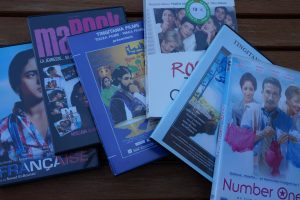Summary:
This article focusses on the circulation of a corpus of films – feature films by women filmmakers with Moroccan funding – in order to interrogate the processes of symbolic and economic valorization of the films. Even though filmmaking consists in a range of gendered activities, “films by women filmmakers” constitute a contentious category that most women filmmakers are uncomfortable with and that film professionals largely ignore. It is nevertheless a necessary category to address the gendered expectations that specific audiences may have in the transnational circulation of the films between Morocco and Europe. From La Braise (1982), by Farida Bourquia, the first film by a woman filmmaker with Moroccan funding to In the Narrow Frame of Midnight by Tala Hadid (2016), there have been altogether 26 feature films directed by women filmmakers with Maghrebi funding, 23 of which have been produced since 2000 and 13 since 2010. But it would be wrong to regard the rise in the number of films by women filmmakers as evidence of the growing presence of women filmmakers in the Moroccan film industry. The statistics mirror the rapid growth in the total number of films produced nationally with films by women filmmakers staying around 10%. These low-budget films have been directed by 18 filmmakers (of whom two are not Moroccan) from 3 different generations, with filmmakers responsible for between one and four films each. Films by women filmmakers with Moroccan funding are much more diverse than a similar corpus in Tunisia or Algeria and do not rely extensively on the social naturalism that characterizes many European Maghrebi coproductions. There are more genre films (comedies or thrillers) and fewer strictly auteur films, i.e. films that are based on the directors’ own scripts.

Based on data collected from institutions (the CCM in Morocco as well as other institutions in Europe) whenever it is available, on interviews with DVD publishers and on interviews with managers of film platforms, this paper will start by considering the circulation of the films via festivals, commercial distribution, small portable video media and platforms, drawing attention to the ways in which the multiplication of access to films on digital media affects the lifecycles of such films. It will provide a typology of four different trajectories for the films in this corpus and comment on the impact of patterns of funding on film circulation. One of the purposes of this paper is to question whether a much more diverse access to film via different media increases the chances for films outside mainstream commercial distribution to reach viewers.
Going to the cinema used to be a widespread pastime in Morocco with 240 cinemas and admissions reaching 39 million in 1982, although Moroccan cinemas mostly screened American, Egyptian and Indian films. With a film production of about 20 films a year today, Morocco has a big “small cinema” that has done well nationally. Notwithstanding the sharp decline in the number of cinemas, Moroccan films account for a quarter of admissions and tend to do well in commercial distribution in Morocco. Films by women filmmakers have been released on Moroccan screens where they have enjoyed moderate success. Some of them have circulated more widely via festivals in Morocco and beyond, particularly in francophone Europe, and some have even seen commercial distribution in Europe.
The venues, forms and timelines for the valorization of artworks have changed, and to interrogate this transformation we draw on Julien Duval and Maria Garcia Parpet’s research (2012) on the valorisation of cultural productions as the outcome of collective mechanisms. These mechanisms depend on a range of agents (institutions, critics and other experts, art middlemen who may or may not be professionals, amateurs), as well as the systems of evaluation (awards, guides, best seller lists, etc.) that shape and condition encounters between films and specific audiences at different stages of their circulation. What are the ways in which the processes of economic and symbolic valorization of the films by women filmmakers are gendered?
Festivals and cinemas still remain the main venues for the valorisation of film because film screenings and releases in the cinemas (unlike DVD releases) are covered by the press. And a number of films by women filmmakers have done very well on the international film festival circuit. The article teases out how certain traits, most notably character development, plot, formal characteristics and specific aspects of auteur films affect the circulation of the films in the festivals, and in fine their trajectory and lifecycle. The analysis highlight the specificity of the process of valorization in France and more generally in Europe.
Last, the article draws attention to the ways in which systems of evaluation have been reconfigured with new actors, notably through the participative web. Meanwhile traditional window release patterns for films have been considerably reduced under the pressure of a parallel informal system of circulation on small portable media that jeopardizes film returns. Unlike cinema releases, the status of VHSs and DVDs in terms of audience remains unclear. While they have contributed to the quick and massive circulation for private viewings of genre films, they have also supplied city library holdings (as well as personal collections), institutions that are central in the constitution of film cultures. Relying on interviews with DVD publishers (and the data they provide which is not neutral) about films in this corpus, this article will highlight the changing status of Moroccan films by women filmmakers as well as their specific contribution to the construction of a national, regional or transnational film heritage.